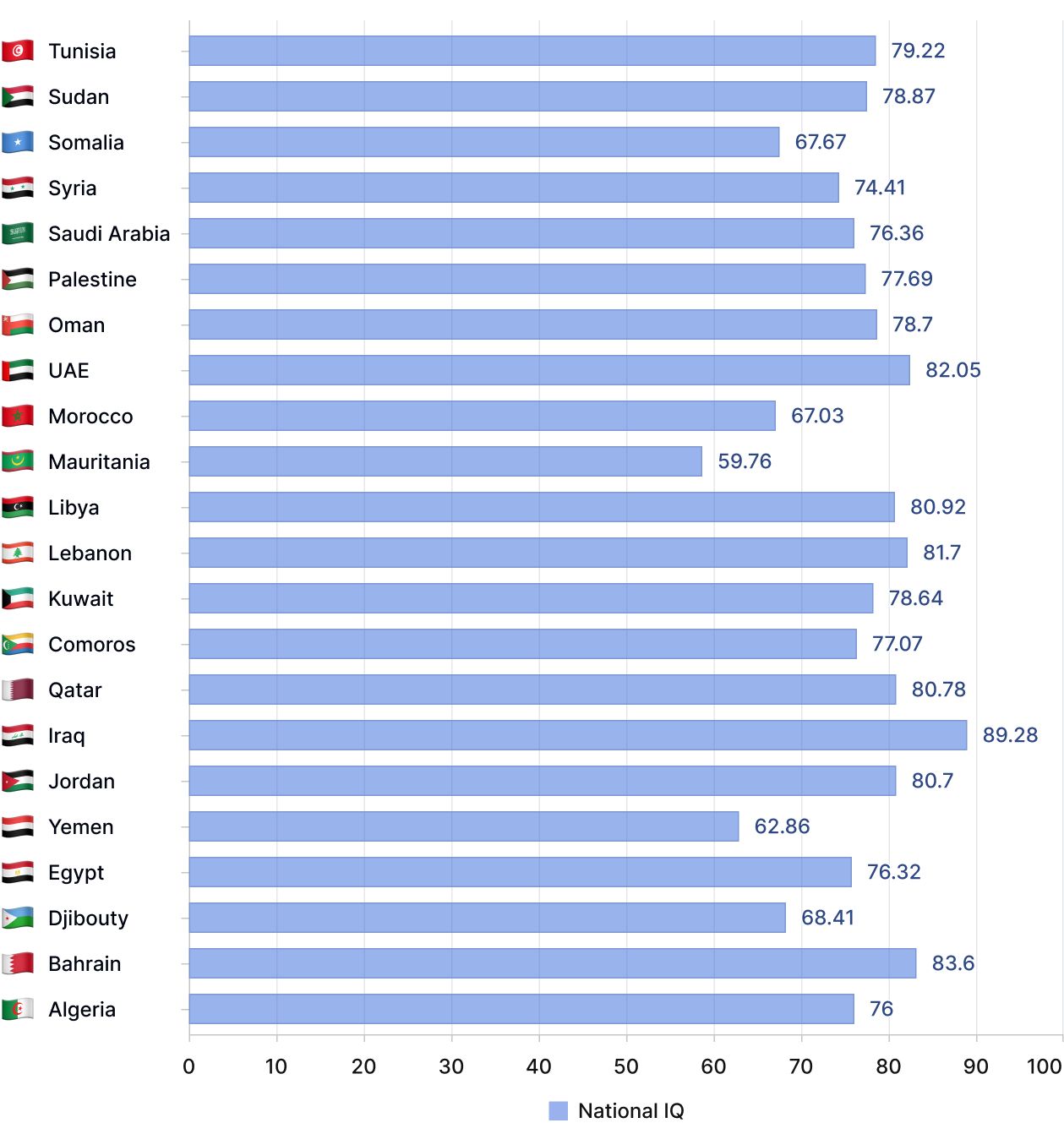Dynamics of National IQ Levels in Arab Countries
The Arab League consists of 22 countries that include Arabic as their national languages and are located in the regions of the Middle East, North Africa, and Eastern Africa.
The national IQ indicator is most strongly correlated with the level of development of the educational system in a country, which, in turn, typically directly depends on the overall socio-economic development. Given that there is significant diversity in the socio-economic development levels among Arab countries, the national IQ indicators also vary significantly across the Arab world.
The national IQ levels by Arab League countries are illustrated in the figure.

Note: Developed based on [1].
As seen in the figure, according to the latest research on national IQ in Arab countries, the highest indicators are found in Iraq (89.28), Bahrain (83.6), and the United Arab Emirates (82.05). The lowest indicators are found in Mauritania (59.76), Yemen (62.86), and Morocco (67.03).
Data for a comparative analysis of the dynamics of the national IQ indicator across the Arab world are lacking, as studies in Arab countries were conducted in different years, using different methodologies, and on different audiences. However, based on data presented in the study by Richard Lynn and David Becker in 2019 [2], it is possible to discern the dynamics of national IQ in certain Arab countries.
For instance, studies in Bahrain were conducted using the TIMSS methodology starting in 2003, when the indicator (hereinafter expressed in IQ scale points) was 78.85. Thereafter, an increase in the indicator was observed until 2015; according to the study conducted that year, the indicator reached 85.38 (though the latest data, as seen in the diagram, shows a decrease of nearly two points).
In Egypt, studies were also conducted using the TIMSS methodology in 2003, when the indicator was 77.67. According to the next study in 2007, it had already decreased to 74.04. According to the latest data, the national IQ level in the country has increased (76.32), but has not reached the 2003 level.
In Yemen, the 2003 studies, using the same methodology, corresponded to an IQ level of 59.49 points. In 2007, the indicator decreased to 49.06. Subsequent studies showed an increase in the national IQ level (to 62.86).
In Jordan, data from studies conducted since 1999 are available, when the indicator in the country was 86.57. By 2003, the indicator had decreased to 84.74. Then, according to 2007 data, it increased to 85.05. According to studies conducted in 2011 and 2015, the indicator decreased, and in 2015 it reached the minimum level for the entire period of studies – 74.43. According to the latest data, the national IQ level in Jordan is 80.7, which is still below the 2011 level, when the indicator was 81.48.
In Qatar, the first studies were conducted in 2006 using the PISA methodology, with an indicator of 73.6. Subsequent studies showed a consistent increase in the indicator until 2015, when it reached 85.58. As seen in the diagram, according to the latest studies, the national IQ level in the country has decreased to 80.78.
The first studies in Kuwait were conducted in 1995 using the TIMSS methodology, with an indicator of 81.3. According to subsequent studies, the indicator never reached this level again, varying over the years from 69.33 (2015) to 78.64 (2019).
Studies conducted in Lebanon in 2003 showed that the national IQ level in the country was 77.57. According to studies conducted in 2007 and 2011, the indicator increased, but in 2015 it decreased, still being higher than in 2003 – 78.24. According to the latest data, it is 81.7 (the maximum for the entire period).
In Morocco, the indicator was 67.79 in 1999. Subsequently, the national IQ in the country fluctuated from 67.03 (current data) to 71.13 (2003).
In the United Arab Emirates (UAE), studies were conducted starting in 2007 (TIMSS). The 2007 indicator was 82.76. Subsequently, the indicator increased, and in 2015 it reached 86.1. According to the latest data, the national IQ level in the UAE has decreased and is 82.05.
According to studies conducted in Oman in 2007, the indicator was 73.64. Subsequently, the indicator increased to 79.86 in 2015. As of now, according to the latest available data, it is 78.7.
In Saudi Arabia, according to studies conducted using the TIMSS methodology in 2003, the national IQ level was 68.15. Subsequent studies using this methodology showed results ranging from 67.34 in 2007 to 80.66 in 2011. Currently, the indicator is 76.36.
In Syria, the 2003 study results, using the same methodology, were equated to an IQ scale of 71.98. By 2007, the IQ level in the country had increased to 78.85, but subsequently decreased – to 74.41 as of now.
Conclusion
As shown by the data, there is no uniform trend in IQ dynamics in the Arab world, which is explained by the varying levels of socio-economic development and internal situations in individual countries, as well as their involvement in international relations. Since the national IQ level responds to the situation in the economy and social sphere, which are influenced by the situation in international relations, it cannot maintain a positive dynamic in turbulent conditions. The prospects for increasing IQ levels are linked to socio-economic development and, in particular, the development of the education system in countries. In turn, increasing the national IQ is one of the most important factors in increasing prosperity.
References:
- Countries by IQ // World Population Review [Electronic resource]. – Mode of access: https://worldpopulationreview.com/country-rankings/average-iq-by-country. – Date of access: 06.02.2024.
- Lynn, R. The Intelligence of Nations / R. Lynn, D. Becker. – London: Ulster Institute for Social Research, 2019. – 436 p.






















